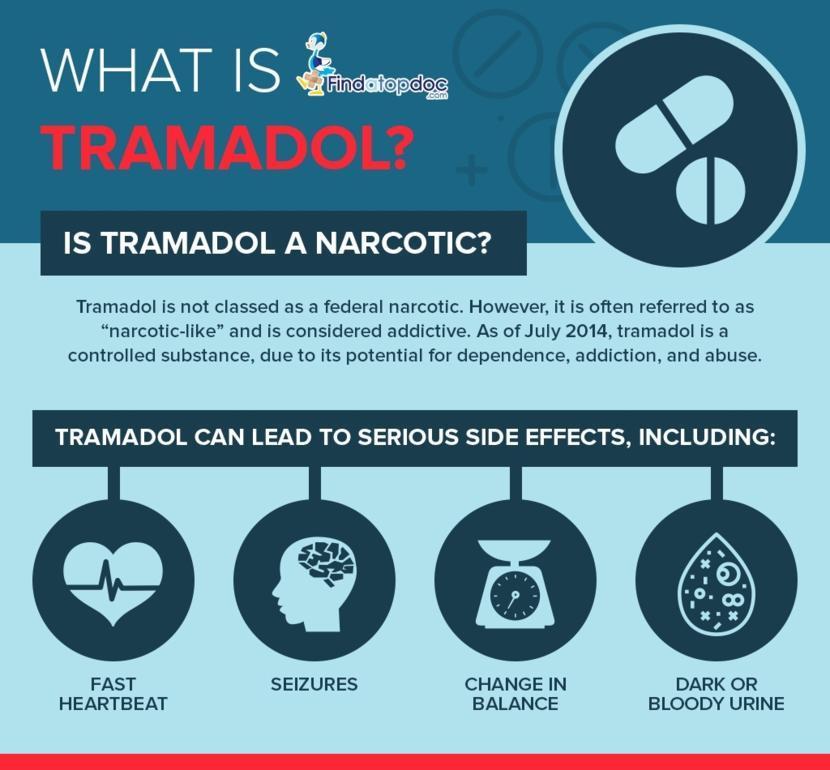Is Tramadol a Narcotic?

Most tramadol users are not aware of the drug's specifications. Therefore, there is always confusion as to whether tramadol is a narcotic or not. The truth of the matter is that this medicine works like a narcotic but is not categorized as one. It is only referred to as "narcotic-like".
Tramadol is not classified as a federal narcotic by the Drug Enforcement Administration (DEA) or the US Food and Drug Administration (FDA). Tramadol is placed in a class of medicines, which are categorized as opiate agonists. Having said this, there are certain states such as Virginia and Kentucky where this drug is classified as a narcotic.
What is tramadol?
Tramadol is a narcotic-like drug, which is given to patients as a pain reliever. They are prescribed by doctors to treat pain that is unbearable, severe, or moderate. The extended-release form of tramadol is given to patients suffering from continuous severe pain. This form of medicine cannot be used as needed by the patient unless it is prescribed.
Important information:
- A person cannot take tramadol if he or she has consumed alcohol or some form of sedatives, tranquilizers, or narcotic drugs in the last few hours.
- Tramadol can reduce or stop one's breathing, especially if the person has just started taking the drug or has changed the dosage.
- Tramadol should not be taken in large amounts or for a longer period of time than prescribed.
- An extended-release pill should not be crushed, broken, or opened.
- The medicine should be swallowed as a whole to prevent any type of exposure to the dose, which can be fatal.
- Some people develop seizures when they take this medicine. However, this side effect is mostly common in people who have had seizures, some head injury in the past, or those who are currently on medications such as antidepressants, narcotics, or specific medications for nausea and vomiting.
What are the causes for concern?
People who are taking tramadol can become addicted to the medicine, even if they are adhering to the prescribed dosage. Below are some of the causes for concern:
- Tramadol should be taken exactly as prescribed by the doctor.
- It should not be shared with another person.
- It can cause addiction, overdose, and at times even death, particularly among children or when a person takes this medicine without a doctor’s prescription.
- If a pregnant woman takes this medication, it can lead to serious withdrawal symptoms in the newborn baby.
- Dangerous side effects can occur in individuals who take tramadol along with alcohol or with any other drugs that tend to cause sleepiness or reduced breathing.
- Tramadol has the capability of interacting with a lot of other drugs and can cause fatal side effects. Therefore, it is important to provide the doctor with all the details about the medicines that you are currently taking.
- Tramadol tablet should not be crushed and this medicine is for oral use only.
- The powder from a crushed tramadol tablet should not be inhaled or diluted with water and then injected into the body.
- If an individual injects or inhales this medicine, it can lead to life-threatening side effects, overdosage, and even death.
What are the precautions for taking this medicine?
Tramadol cannot be taken by a person who is allergic to the drug or has:
- Severe asthma or breathing problems
- Blockage in the abdomen or intestines
- Has recently used alcohol, sedatives, or some narcotic drugs
- Has used MAO inhibitors in the last two weeks
A seizure is one of the dangerous side effects of tramadol and it has affected many people. Consult with the doctor to discuss the risk of seizures. The risk of seizures is higher among individuals who have:
- A history of a severe head injury or some other seizure disorders
- A drug or alcohol addiction in the past
- A metabolic disorder
- Made use of some specific antibiotics, antifungal medications, medicines for the heart and blood pressure problems, or medicines for treating AIDS.
There are some medications that have the ability to interact with tramadol, and can cause a medical condition known as the "serotonin syndrome". Therefore, the doctor should be completely aware if the patient is taking any medicine for treating depression, mental disorders, Parkinson’s disease, migraine headaches, some infections, or for preventing nausea and vomiting. Consult the doctor before making any changes in the dosage and timing of taking the medicines.
To make sure that tramadol is a safe drug to take, it is important that the patient informs the doctor if he or she has any of the following medical conditions:
- Liver or kidney disease
- Stomach disorder
- Past record of drug addiction, alcohol addiction, mental problems, or suicide attempts
There are more chances of tramadol causing breathing issues in adults and individuals who are very ill, half-starved, or debilitated.
Tramadol has the tendency of becoming a habit-forming drug. Therefore, the drug should be taken only if prescribed. This medicine should not be shared with someone else, particularly with a person who has a past record of drug abuse. Keep the medicine in a safe place where others cannot find it easily. It is against the law to sell or give tramadol to another person.
If expecting mothers use tramadol, the newborn baby can become dependent on the drug. There is also a possibility that it will lead to life-threatening withdrawal symptoms in the baby. Babies who are born dependent on such addictive medications need special medical treatment for a couple of weeks. Therefore, it is important to inform the doctor if you are pregnant or planning to have a child.
Tramadol can pass into the breast milk and may affect the nursing baby. Therefore, mothers should not breastfeed their babies while taking this medicine.
This medicine should not be given to a person who is less than 16 years of age without the consultation of the doctor.
How should tramadol be taken?
Tramadol should be taken exactly as prescribed by the doctor. Strictly follow the instructions that are mentioned on the prescription label. There is a possibility that this medicine can slow or stop breathing, particularly when one first starts taking this medicine or changes the dose. Inform the doctor if you feel that the medicine has stopped working as it should or is not giving any pain relief.
You must stop taking any other narcotic pain medications while on this drug. Tramadol can be taken along with food or on an empty stomach, but it important that it is taken in a similar way every time. The extended-release form of the tablet should not be crushed or opened, but should be swallowed whole.
If a person is using the extended-release tablet form of this medicine, there is a chance that the shells of the tablets can pass into the stool. This is a common sign and does not indicate that one is not receiving sufficient quantity of the medicine.
Do not suddenly stop taking this medicine, since this can lead to withdrawal symptoms. Consult your doctor on how to safely and gradually stop taking this drug.
Tramadol should be stored at room temperature, and kept away from moisture and heat.
What happens if you miss a dose of tramadol?
Since tramadol is taken for pain relief, there is less of a possibility of missing the dose. However, if you do miss a dose, skip the missed dose. Do not try and take extra doses to compensate for the missed dose as this can lead to overdose.
What happens in case of an overdose?
Seek immediate medical attention in case of a tramadol overdose. An overdose of this drug can be dangerous, especially in children or a person who has taken it without a prescription. Some of the overdose symptoms are slow breathing, slow heart rate, drowsiness, fainting, and cold and sweaty skin.
What should be avoided while taking tramadol?
- Do not drink alcohol, since this can lead to fatal side effects and even death.
- Check all food and medicine labels to ensure they do not contain alcohol.
- This drug has the tendency to affect one's thinking, motor skills, and reaction times. Therefore, you must avoid driving, operating machinery, or any other activity that requires your complete attention.
- Side effects such as dizziness and drowsiness can lead to falls or other accidents, so rest after consuming this medicine until you're sure that you no longer feel such side effects.
What are the side effects of tramadol?
A person will need immediate medical attention if he or she shows the following signs and symptoms after taking tramadol:
- Allergic reaction
- Hives
- Breathing problems
- Swelling of the face, lips, tongue, or throat
Tramadol should be kept away from children. If a child has accidentally consumed this medicine, then he or she should be given emergency medical help.
Some side effects in children can include:
- Noisy breathing
- Sighing
- Breathing slowly with long breaks between each breath
- Being extremely sleepy or finding it difficult to get up from sleep
- Blue-colored lips
Some other side effects of tramadol include:
- Seizures
- Slow or shallow breathing
- Infertility
- Missed menstrual periods
- Impotence
- Sexual problems
- Lack of interest in sex
- Anxiety
- Nervousness
- Nausea
- Vomiting
- Diarrhea
- Constipation
- Stomach pain
- Loss of appetite
- Dizziness
- Fainting
- Tiredness
- Headache
- Itching
- Sweating
- Fever
- Sore throat
- Swelling of the face or tongue
- Burning sensation in the eyes
- Skin problems – red or purple skin rash, which gradually spread along with blistering and peeling
A person must seek immediate medical attention if he or she has symptoms of serotonin syndrome, which include:
- Hallucination
- Agitation
- Sweating
- Fever and chills
- Fast heart rate
- Stiffness of muscles
- Lack of coordination
- Nausea
- Vomiting
- Diarrhea
What is the proper dose of tramadol?
The dosage of tramadol will differ from person-to-person, depending on the severity of the pain, age, and other factors. Follow the instructions of the doctor on the dose that needs to be taken and the total number of times it needs to be taken. Avoid prolonged use of this medicine without consulting the doctor. The doctor may make changes to the dosage depending on any side effects or pain relief in the patient.
The quantity of medicine one takes will be dependent on the strength of the drug. The number of doses, the time between two doses, and the duration that the medication has to be taken will determine how the doctor prescribes the medicine.
The typical dosage for chronic pain:
1) Oral dosage form (extended-release tablets):
- Adults: In the beginning, the doctor may prescribe 100 mg to be taken once a day. Gradually, the doctor may suggest increasing the dosage if required. However, the dose will not exceed more than 300 mg each day.
- Children: The use and dose will be based on the doctor’s instructions.
2) Oral dosage form (tablets):
- Adults and teenagers (16 years and above): Initially, the doctor may prescribe 50–100 mg to be taken every four to six hours as required. The dose will be gradually increased if needed. However, the dose will not be more than 400 mg each day.
- Children younger than 16 years old: The use and dose will be based on the doctor’s instructions.
Dosage for moderate to severe pain:
1) Oral dosage form (disintegrating tablets):
- Adults and teenagers (16 years and above): In the beginning, the doctor will suggest a 50–100 mg dose every four to six hours as required. Then the dose will be increased after a period of time if required. However, the dose will not exceed more than 400 mg each day.
- Children younger than 16 years old: The use and dose will be based on the doctor’s instructions.
2) For oral dosage form (tablets):
- Adults and teenagers (16 years and above): Initially, they will be recommended a dose of 25 mg each day, which has to be taken every morning. The doctor may later suggest increasing the dose depending on the patient's condition. However, the dose will not exceed 400 mg each day.
- Children younger than 16 years old: The use and dose will be based on the doctor’s instructions.














